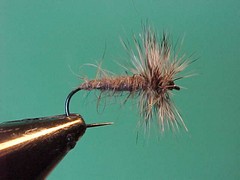The gray duster was one of the first flies I tied. It was at a fly tying course at Illawarra Fly Fishers in Wollongong and this fly was selected because of its simplicity and of course the fact that it works. Over time my tie of a gray duster has been corrupted to be a sort of melding of the gray duster that I was first introduced to and an Adams irresistible. The original gray duster was designed as a midge cluster fly and consequently has no tail. The tie below is of the fist gray duster I was introduced to and what I understand to be the original tie. The link to my corrupted variant is as follows.
[example Link=”p=10056″ Title=”Chatto’s gray duster variant”]
 |
Materials
| Hook | Thread | Body | Hackle |
|---|---|---|---|
| Dry fly | Brown | Gray rabbit underfur | Badger |
Process
| A |
[member Link=”p=10018″ Title=”Understanding hooks”] |
 |
|---|
| D |
[member Link=”p=2838″ Title=”Neat thread heads”] |
 |
|---|


